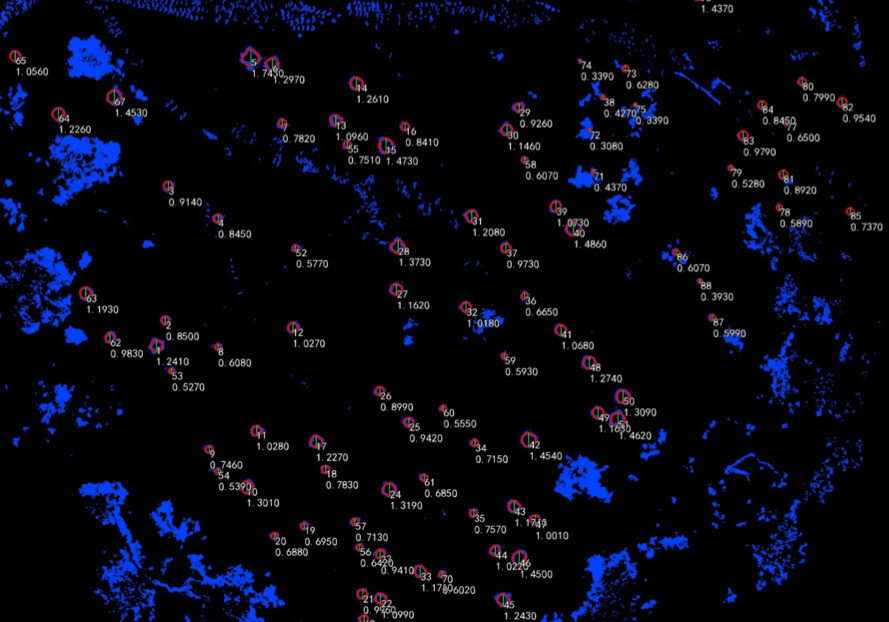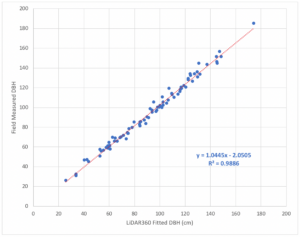



A tree’s diameter at your breast or chest height is the most common tree measurement made on a tree by forestry professionals. All growth, volume and yield tables are calculated to correspond with DBH. GreenValley International investigated the accuracy of diameter at breast height (DBH) measurements extracted from handheld mobile LİDAR. Learn how LİDAR works!
For this case study, a 8100 sq. m site in Berkeley, California is selected to serve as study area. This location contained Tasmanian blue gum (Eucalyptus globulus) and coast redwood (Sequoia sempervirens) trees planted by University of California landscape architects during the 20th Century. Prior to data collection a short amount of time was spent inspecting the study site and planning the route of travel that would be taken by the LİDAR operator. Data was collected in handheld mode to ensure that the output would contain LiDAR returns from objects in the upper most portions of the forest canopy. The operator completed two loops in roughly 10 minutes and traveled approximately 330 meters (0.2 miles). Equipment set-up and breakdown times added 5 minutes to the total workflow length.
The collected 3D point cloud data was then imported into LiDAR360 where it was used to rapidly generate a high-fidelity stem map and an individual tree identification system (Tree ID) which assigned a unique number to every tree. Individual tree diameters were determined by first extracting a cross section of the point cloud that fell between 1.2 m and 1.4 m above ground level before manually identifying the individual tree points and then using the TLS Forest Editor to fit a circle to points that represented a tree stems hull at “breast height”. In total, 87 individual tree diameters were extracted from the LiBackpack data.


The visual outputs of the process provide a high-fidelity 2D visualization of individual tree stem locations mapped with cm-level horizontal and vertical accuracies. Each red circle represents an individual tree stem and is labeled with a unique two-digit Tree ID number. The green lines bisecting each fitted circle represent the diameter measurements attributed to each Tree ID.
To assess the accuracy of the fitted DBH measurements, a field technician took in situ stem diameter measurements of all trees located within the study area using a traditional DBH measurement. The species type was also determined and recorded by the technician for all trees included in the field inventory.
DBH measurements from the field data were compared to their corresponding LiDAR360 fitted DBH measurements and the differences between the two values determined. These difference values represented the magnitude and direction of the error found in the fitted dataset at the individual tree level. When all trees for which field data was available were included in a statistical analysis of the entire study area, the mean absolute error (MAE) was determined to be 3.45 cm (~ 1.36 inches). At the site-level LiDAR360 fitted DBH values tended to be less than the field measured DBH values with 71% of the observed discrepancies between the two values being negative and the square root of the mean difference (RMSE) was 6.01 cm (~ 2.37 in).


The accuracy of DBH values was also assessed by running a simple linear regression to determine the coefficient of variation (R2) that existed between the two related datasets. This is an important test to run because it is often the case that forest inventory data is hierarchical in that individual tree level data is used to estimate plot level data which in turn is used to estimate stand and forest level data. An error in measurement of single trees carries through become error in the estimates of successively larger scale estimates of forest cover and volume. The linear regression analysis revealed that the R2 value for all fitted-field measurement pairings was 0.9774.
This analysis of DBH measurements derived from LiBackpack data using LiDAR360’s Forest Module demonstrated that a high level of accuracy (RMSE to 4.26 cm or ~ 1.68 inches) can be achieved. Accurate individual tree metrics scale up to become reliable estimates of volume, cost, and value that are of great interest to natural resource managers and forest landowners.
Learn what type is LİDAR you need with “Do you know how many types of LiDAR are there?“

The LiBackpack is a versatile handheld mobile LiDAR system that integrates laser scanning with SLAM (simultaneous localization & mapping) technologies to rapidly generate high accuracy geospatial products with minimal data processing.
In future LiDAR in Forestry Applications articles we will take a deeper dive into methods that can be used to improve the accuracy of DBH measurements obtained from LiBackpack data using LiDAR360’s TLS Forest Module including:
For more information, please visit GreenValley International.